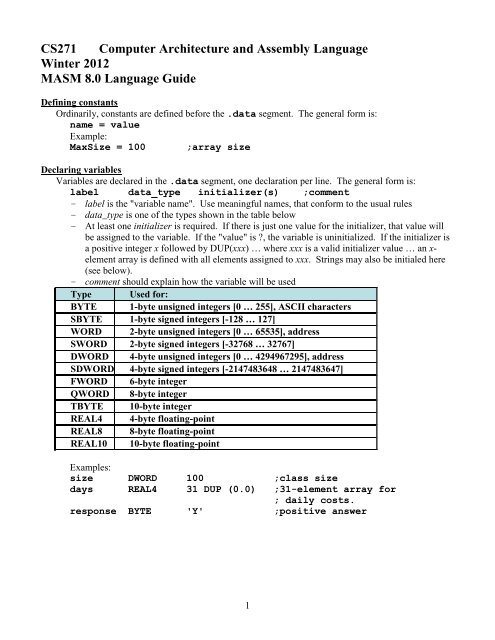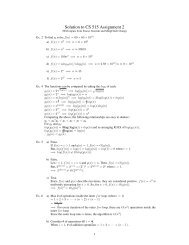Guide to MASM Programming - Classes
Guide to MASM Programming - Classes
Guide to MASM Programming - Classes
You also want an ePaper? Increase the reach of your titles
YUMPU automatically turns print PDFs into web optimized ePapers that Google loves.
CS271 Computer Architecture and Assembly Language<br />
Winter 2012<br />
<strong>MASM</strong> 8.0 Language <strong>Guide</strong><br />
Defining constants<br />
Ordinarily, constants are defined before the .data segment. The general form is:<br />
name = value<br />
Example:<br />
MaxSize = 100 ;array size<br />
Declaring variables<br />
Variables are declared in the .data segment, one declaration per line. The general form is:<br />
label data_type initializer(s) ;comment<br />
– label is the "variable name". Use meaningful names, that conform <strong>to</strong> the usual rules<br />
– data_type is one of the types shown in the table below<br />
– At least one initializer is required. If there is just one value for the initializer, that value will<br />
be assigned <strong>to</strong> the variable. If the "value" is ?, the variable is uninitialized. If the initializer is<br />
a positive integer x followed by DUP(xxx) … where xxx is a valid initializer value … an x-<br />
element array is defined with all elements assigned <strong>to</strong> xxx. Strings may also be initialed here<br />
(see below).<br />
– comment should explain how the variable will be used<br />
Type Used for:<br />
BYTE 1-byte unsigned integers [0 … 255], ASCII characters<br />
SBYTE 1-byte signed integers [-128 … 127]<br />
WORD 2-byte unsigned integers [0 … 65535], address<br />
SWORD 2-byte signed integers [-32768 … 32767]<br />
DWORD 4-byte unsigned integers [0 … 4294967295], address<br />
SDWORD 4-byte signed integers [-2147483648 … 2147483647]<br />
FWORD 6-byte integer<br />
QWORD 8-byte integer<br />
TBYTE 10-byte integer<br />
REAL4 4-byte floating-point<br />
REAL8 8-byte floating-point<br />
REAL10 10-byte floating-point<br />
Examples:<br />
size DWORD 100 ;class size<br />
days REAL4 31 DUP (0.0) ;31-element array for<br />
; daily costs.<br />
response BYTE 'Y' ;positive answer<br />
1
Declaring strings<br />
Strings are declared as BYTE, and must end with an extra 0. At first they look different from other<br />
variables, but you will see that they are pretty much like everything else.<br />
Examples:<br />
warning BYTE "Keep your seatbelt fastened ...", 0<br />
;part of the introduction<br />
prompt BYTE "Enter an integer : ", 0<br />
;<strong>to</strong> get data from the user<br />
Registers<br />
<strong>MASM</strong> refers <strong>to</strong> registers by name. Technically, most of the registers can be set <strong>to</strong> anything, but<br />
some of them are usually used for specific purposes.<br />
eax, ebx, ecx, edx: general purpose, but some instructions give you no choice about which<br />
registers <strong>to</strong> use. E.G., ecx is the counter for the loop instruction; eax holds<br />
the dividend and quotient for the div instruction, and edx hold the remainder.<br />
ax, ah, al, etc. "partial" registers (analogous names for ebx, ecx, edx), ax refers <strong>to</strong> the low<br />
16 bits of eax, al refers <strong>to</strong> the low 8 bits of ax, and ah refers <strong>to</strong> the high 8 bits<br />
of ax.<br />
esi<br />
source index, often used <strong>to</strong> hold an address or an offset<br />
edi<br />
destination index, often used <strong>to</strong> hold an address or an offset<br />
ebp<br />
base pointer, often used <strong>to</strong> hold the address of the first element of an array<br />
esp<br />
stack pointer, maintained by the system when a push or pop instruction is<br />
executed<br />
si, di, bp, sp low 16 bits of esi, edi, ebp, and esp respectively<br />
Executable statements<br />
Instructions are placed inside procedures, which are defined in the .code segment. The general form<br />
of a procedure is<br />
procname PROC<br />
; procedure description<br />
; preconditions: (registers required)<br />
; postconditions:(registers changed)<br />
<br />
procname ENDP initializer(s) ;comment<br />
The general form of an instruction is<br />
label: opcode operand,[operand] ;comment<br />
– label is used <strong>to</strong> mark a target. Use meaningful names that conform <strong>to</strong> the usual rules.<br />
Suggestion: put each label appear on its own line.<br />
– opcode is a <strong>MASM</strong> instruction (see <strong>MASM</strong> Instruction Manual )<br />
– operands are registers, constants, literals, variables, labels, etc. Depending on the opcode, one<br />
or more operands may be required<br />
– comment should explain the purpose of the instruction. Suggestion: write an explana<strong>to</strong>ry<br />
comment for each logical group of instructions. Instructions should be grouped so that they<br />
require no more than a one-sentence comment <strong>to</strong> explain their purpose.<br />
– The fields of an instruction must appear in the order shown. Opcode and operands must be on<br />
the same line. Any field of an instruction may be empty (unless operands are required by the<br />
opcode).<br />
2
The call instruction:<br />
– used for calling a procedure … internal or library. Be sure that you understand the pre and<br />
post conditions for a call. Parameters can be passed in a variety of ways, including using the<br />
system stack. A procedure might use values in certain registers (pre-conditions) and/or change<br />
registers (postconditions).<br />
– Example:<br />
mov ecx,IntegerCount<br />
call ArraySum<br />
The mov instruction:<br />
– used for assigning a value <strong>to</strong> a register or variable. The first operand is the destination<br />
(register or memory). The second is the source or value <strong>to</strong> be assigned (register, memory,<br />
constant, or literal).<br />
– Examples:<br />
mov ecx,integerCount<br />
mov response,'N'<br />
mov ebx,eax<br />
Arithmetic instructions:<br />
– used for adding, subtracting, etc., a value <strong>to</strong> a register or variable. The first operand is both an<br />
argument and the destination (register or memory). The second is the source or value <strong>to</strong> add,<br />
subtract, etc. (register, memory, constant, or literal).<br />
– Examples:<br />
add ecx,25<br />
sub value,edx<br />
sub ebx,eax<br />
– The mul and div instructions are used for unsigned operations, and use some implied operand<br />
registers. (See the <strong>MASM</strong> Instruction Manual.) Before using either of these instructions, it is<br />
a good idea <strong>to</strong> set the edx register <strong>to</strong> zero (unless you intend <strong>to</strong> divide a QWORD). The mul<br />
operation multiplies its operand times eax, and puts the result in eax with overflow in edx.<br />
The div operation divides the edx:eax combination (high-order bits in edx, low-order bits in<br />
eax) by the operand, and puts the integer quotient in eax and the remainder in edx. Note that<br />
the operand must be a register or a variable (not literal or constant). Be sure that these implied<br />
registers are not being used for something else when a mul or div instruction is executed.<br />
– Examples:<br />
mov eax,value<br />
mul ebx ;result is in edx:eax<br />
– or<br />
mov eax,value<br />
xor edx,edx ;set edx <strong>to</strong> zero<br />
div ebx ;quotient is in eax, remainder is in edx<br />
3
– The imul and idiv instructions work in the same way as mul and div, but are used for signed<br />
values. However, instead of setting edx <strong>to</strong> zero for idiv, it is necessary <strong>to</strong> extend the sign of<br />
the value in eax in<strong>to</strong> edx.<br />
– Examples:<br />
mov eax,value<br />
imul ebx ;result is in edx:eax<br />
– or<br />
mov eax,value<br />
cdq<br />
;extend sign of eax in<strong>to</strong> edx<br />
idiv ebx ;quotient is in eax, remainder is in edx<br />
Comparison and branching instructions:<br />
– used for implementing decision and repetition control. There are several forms, but a few<br />
examples will probably suffice. Things might seem a bit primitive here …<br />
– Example: Translate this decision structure in<strong>to</strong> <strong>MASM</strong>.<br />
if (x > 10) do one thing, else do another thing<br />
decide:<br />
mov ebx,x<br />
cmp ebx,10<br />
jle lessEqual<br />
greater:<br />
call doSomething<br />
jmp endDecide<br />
lessEqual:<br />
call doAnotherThing<br />
endDecide:<br />
Note that labels decide and greater are not required; they just help <strong>to</strong> clarify the structure.<br />
Also note that the test is for the opposite condition in order <strong>to</strong> skip the "true" block. Don't<br />
forget <strong>to</strong> skip the "else" block if the "true" block is executed.<br />
–<br />
– Example: Translate this pre-test loop in<strong>to</strong> <strong>MASM</strong>.<br />
while (user enters integers greater than 0) do something<br />
initialize:<br />
call ReadInt<br />
pretest:<br />
cmp eax,0<br />
jle endloop<br />
call doSomething<br />
call ReadInt<br />
jmp pretest<br />
endloop:<br />
ReadInt is from the Irvine32 library, and puts its value in<strong>to</strong> eax. Also note that the loop<br />
control condition must be set before the repeated code, and must be reset inside the loop<br />
before jumping back <strong>to</strong> the <strong>to</strong>p of the loop.<br />
4
– Example: Translate this counted loop in<strong>to</strong> <strong>MASM</strong>.<br />
for (k = 1 <strong>to</strong> 10) do something<br />
initialize:<br />
move ecx,10<br />
forLoop:<br />
call doSomething<br />
loop forLoop<br />
endFor:<br />
The ecx register is au<strong>to</strong>matically decremented and tested by the loop instruction. The loop<br />
terminates when ecx becomes 0. To make this a true for loop, another test is required before<br />
entering the loop. Be sure that the loop body doesn't mess up ecx.<br />
Input/output:<br />
– Beginners should use the I/O procedures defined in the Irvine32 library.<br />
– Examples:<br />
call ReadInt<br />
mov value,eax ;get value from the user<br />
mov eax,value<br />
call WriteInt<br />
;display value<br />
mov edx,offset string1<br />
mov ecx, SIZEOF string1<br />
dec ecx<br />
call ReadString<br />
mov strSize,eax<br />
call Crlf<br />
; address of string1<br />
; max number of characters<br />
; leave space for zero-byte<br />
; input the string<br />
; save the length<br />
; new line<br />
mov edx,offset prompt ; display a prompt<br />
call WriteString<br />
Note the use of specific registers. String procedures use references (offset); this is called<br />
register indirect addressing. See examples in Masm615\Examples.<br />
Addressing modes:<br />
<strong>MASM</strong> has several ways <strong>to</strong> access data:<br />
– Immediate Use constant as operand<br />
Examples: mov eax,10<br />
add eax,20h<br />
– Direct Set register <strong>to</strong> address of global<br />
Example: mov esi,OFFSET var1<br />
– Register Use register as operand<br />
Examples: mov var1,eax<br />
add edx,eax<br />
5
– Register indirect Access memory through address in a register<br />
Examples: mov [esi],25<br />
add [eax],ebx<br />
mov eax,[edi]<br />
Brackets [ ] mean "memory referenced by the address in". Note that the following<br />
instruction is invalid because it attempts <strong>to</strong> add memory <strong>to</strong> memory:<br />
add [eax],[edi]<br />
– Indexed “array” element, using offset in register<br />
Examples: mov edi,0<br />
mov array[edi],eax<br />
add edi,4<br />
mov array[edi],ebx<br />
This means "add the value in [ ] <strong>to</strong> address of global".<br />
– Base-indexed Start address in one register; offset in another;<br />
add the registers <strong>to</strong> access memory<br />
Examples: mov edi,OFFSET array<br />
mov ecx,12<br />
mov eax,[edi+ecx]<br />
mov edx,4<br />
mov ebx,[edi+edx]<br />
mov [edi+ecx],ebx<br />
mov [edi+edx],eax<br />
– Stack Memory area specified and maintained as a stack;<br />
stack pointer in register esp<br />
Examples: push eax<br />
add eax,ebx<br />
mov var1,eax<br />
pop eax<br />
Note: the esp "stack pointer" is maintained au<strong>to</strong>matically by the push and pop instructions.<br />
6

















